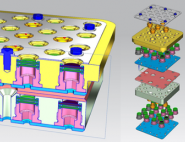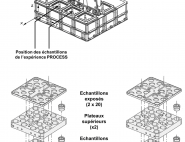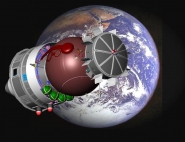Mission

EXPOSE is an equipment dedicated to exobiology, developed by ESA for medium to long term flights, installed outside the International Space Station. The equipment conceived to allow exposure of chemical and biological samples whilst recording data on temperature and effective duration of exposure. It is installed on one of the ISS external balconies.
Three EXPOSE experiments have been developed: EXPOSE-E, EXPOSE-R, and EXPOSE-R2. EXPOSE-E is installed on the European module Columbus, and more particularly, on the EuteF platform, while EXPOSE-R and EXPOSE-R2 are installed on the Russian module Zevzda.
Each of these EXPOSE facilities includes several simultaneous experiments. The different experiments consist in exposing solid molecules, gas mixtures or biological samples to the radiations in space, to space vacuum and to temperature fluctuations.
EXPOSE-E experiments are:
- Process, study of solar UV effects on amino acids and other organic compounds placed in terrestrial orbit.
- Adapt, study of radiation effect on micro-organisms in meteoritic analogues.
- Protect, study of spore resistance to space conditions, and their ability to recover from the damage done by this exposure.
- Life, study of radiation effect on lichens, mushrooms, and symbiotes.
- Seeds, exposure of seeds to space conditions and study of their ability to resist radiations.
- Dosis, Dobis & R3D, radiations and radiance sensors.
EXPOSE-R experiments are:
- Amino, study of solar UV effects on amino acids and other organic compounds placed in terrestrial orbit.
- Endo, study of radiation effect on endolithic micro-organisms (living under rock surface).
- Osmo, study of osmophilic micro-organism (living in a medium of high sugar concentration) exposure to space environment.
- Spores, study of spores placed inside artificial meteorites.
- Photo, study of solar radiation effect on genetic material of spores.
- Subtil, study of mutagen effect of space environment on bacterium spores (Bacillus subtilis).
- Pur, study of space environment effect on T7 phage, its DNA and of polycristalline uracil.
- Organic, study of the evolution of organic matter placed in space.
- IMBP, terrestrial organism exposure to a latent state.
EXPOSE R-2 experiments are:
- Biomex (Biology and Mars Experiment)
- Boss (Biofilm Organisms Surfing Space)
- Biochip
CNES's participation to EXPOSE mainly consists in supporting the development of the PROCESS and AMINO experiments. CNES has also financially supported the SEEDS experiment.


